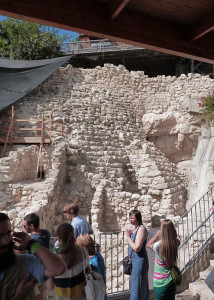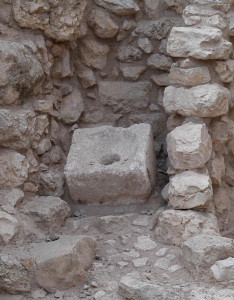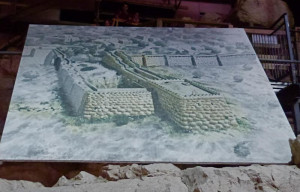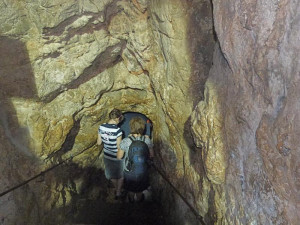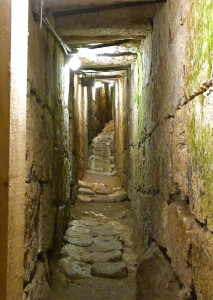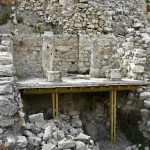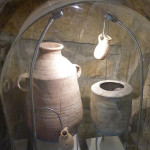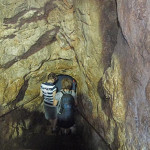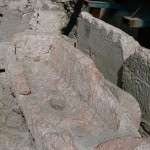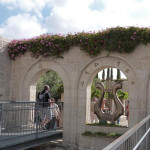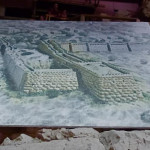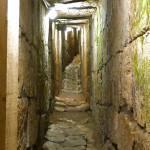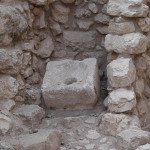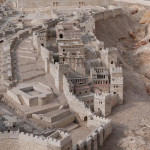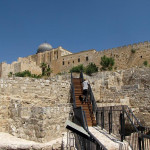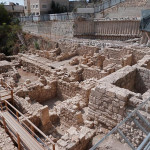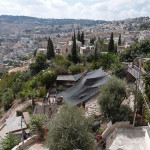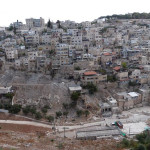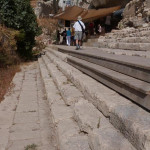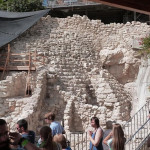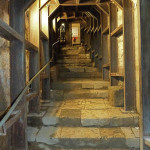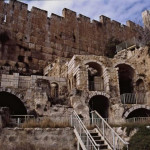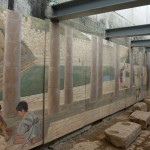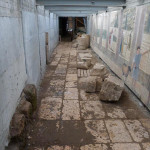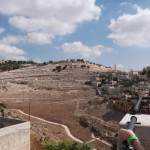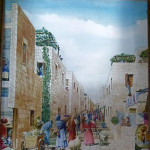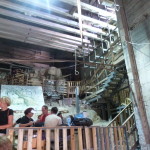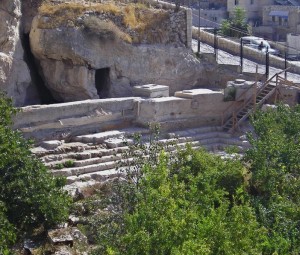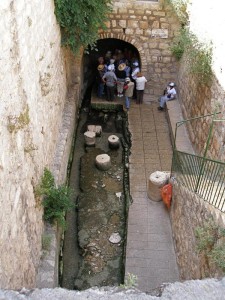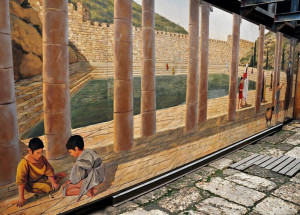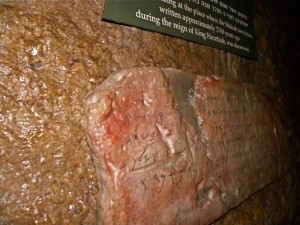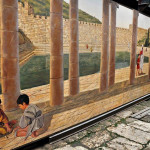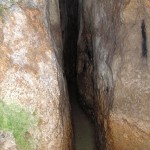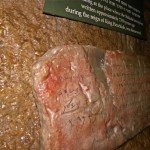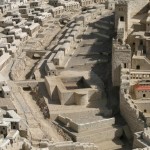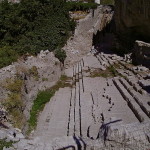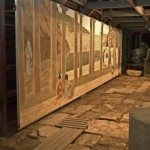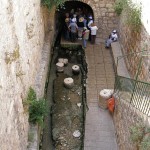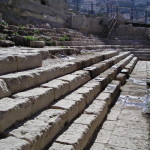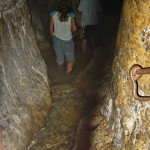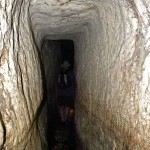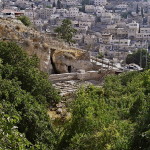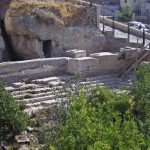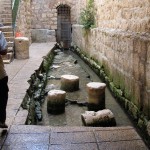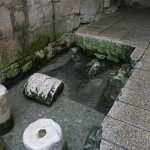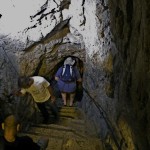Jerusalem
The original inhabitants of Jerusalem lived not on the site of today’s Old City, but on a narrow ridge descending south from the present Temple Mount.
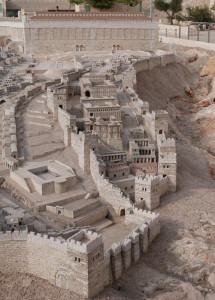
City of David in Model of Ancient Jerusalem at Israel Museum, with Pool of Siloam at left (Seetheholyland.net)
This is where King David captured the fortress of a Canaanite tribe, the Jebusites, 1000 years before Christ. On this slender spur — about 5 hectares (12 acres) in area — David established his capital and pitched a tent to house the Ark of the Covenant.
The site possessed the natural defences of the Hinnom valley to the south, the Kidron Valley to the east, and the Tyropoeon Valley (now largely filled in by the debris of centuries) to the west. And it had fresh water from the Gihon Spring gushing at its foot.
Besides David and his son Solomon, this would have been the stamping ground of kings Hezekiah and Josiah and the prophets Isaiah and Jeremiah.
Standing on the observation platform of the City of David archaeological park, it is easy to see how David could have looked down from the roof of his palace and spied the beautiful Bathsheba bathing (2 Samuel 11: 2).
Excavations are intense and controversial
Today the area is pitted with archaeological digs as intensive efforts continue to uncover evidence of David’s city. While there are claims that parts of David’s palace have been uncovered, archaeologists are generally unconvinced (and David’s tomb remains elusive).
The excavations have also attracted controversy. Though the City of David is a national park, it is run by a private Jewish settler organisation, the Elad Foundation, which also funds its archaeological work. Tensions have arisen as excavations and park facilities spread down the slope of the Kidron Valley and into properties of the predominantly Arab village of Silwan.
At the summit of the excavated area is a massive stepped-stone structure. Dating from before the 10th century BC, it is believed to have served as a retaining wall for David’s palace or the Canaanite fortress that preceded it.
Later, when Solomon had built the first Temple on Mount Moriah (now the Temple Mount), stately homes for Jerusalem’s elite and royal functionaries were built on the stepped-stone structure. Their opulent character is indicated by artifacts including cosmetics and remains of furniture made of wood imported from Syria.
One four-room building immediately below the stepped-stone structure, called the House of Ahi’el (because the owner’s name was found on a pottery fragment), had an external stone staircase leading to a second storey. In one room a limestone toilet seat was embedded in the plaster floor, with a cesspit beneath it.
Clay seals bear names from the Bible
There was also an official archive in old Jerusalem. Its papyrus documents went up in flames with the rest of the royal quarter when the Babylonians destroyed the city in 586 BC, but dozens of clay seals survived.
Some of the seals bear names known from the Bible, such as Gemariah son of Shaphan, a high-ranking official in the court of King Jehoiakim (Jeremiah 36: 9-12), and Azariah son of Hilkiah, a priest who served in the Temple at the time of the exile to Babylon (1 Chronicles 9:10).
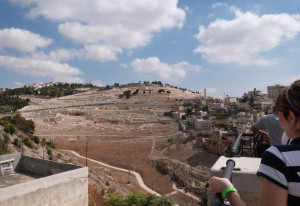
Looking down from the City of David observation platform, with the Mount of Olives Jewish cemetery across the Kidron Valley (Seetheholyland.net)
Another clay seal found in the City of David contains the name of Bethlehem — the first mention of this ancient city outside of the Bible.
At the base of the Temple Mount are the remains of a Byzantine monastery, with adjacent winery and hospice for pilgrims. This is probably the “monastery of virgins” described by the 6th-century pilgrim Theodosius.
Water source was fortified
The importance of water to Jerusalem’s early residents is evident from the elaborate tunnels and fortifications they established to access, manage and defend it.
Crucial to the city’s survival was the Gihon Spring — shown on some old maps as the Virgin’s Spring, a name that may owe its origin to an earlier Jewish name, the Well of Miriam (the sister of Moses). Since Miriam is Hebrew for Mary, this could explain an unlikely Christian legend that the Virgin Mary washed Jesus’ swaddling clothes here.
As far back as 1800 BC, the Jebusites fortified the Gihon with massive guard towers. They cut a system of tunnels from within their city walls to a rock-cut pool, also fortified, that received water through a feeder channel from the spring.
Visitors can now traverse some of this subterranean water system, known as Warren’s Shaft (after the British engineer who discovered it in 1867).
They can also walk from the Gihon Spring through the 530-metre Hezekiah’s Tunnel. King Hezekiah’s workmen dug this in the 7th century BC to bring water to the Pool of Siloam inside his city, in preparation for an impending siege by the Assyrians.
If this dark and winding tunnel, with water thigh-high in places, is too daunting, an adjacent Canaanite tunnel provides a well-lit and dry-shod alternative.
Herodian street was used by Jewish pilgrims
From the Pool of Siloam, visitors can walk on a section of the Herodian street — now also below ground level — that hundreds of thousands of Jews used three times a year to ascend to the Temple during pilgrim feasts. Jesus almost certainly walked this way.
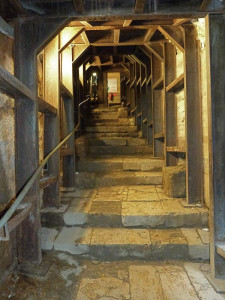
Excavated section of Herodian street that led from Pool of Siloam to Temple Mount (Seetheholyland.net)
Beneath the level of this street is another tunnel — the drain that took stormwater and sewage from the Old City to the Kidron Valley in Roman times.
Now cleaned out, this tunnel enables visitors to walk 700 metres uphill, along the edge of the Tyropoeon Valley and under the Old City wall, to an exit near the Western Wall.
Among the items discovered in this tunnel were a rare gold bell, perhaps once sewn to a high priest’s garment, and an ancient silver shekel, customarily used to pay the half-shekel head tax to the Temple.
A more sombre find was a Roman sword, with its leather sheath partly intact.
As the Romans overtook Jerusalem in AD 70 during the First Jewish-Roman War, with the Temple in flames, the last of the Jewish rebels hid in the sewers. “Those in the sewers were ferreted out, the ground was torn up, and all who were trapped were killed,” reported the historian Flavius Josephus.
In Scripture:
David captures Jerusalem: 2 Samuel 5:6-7
David sees Bathsheba bathing: 2 Samuel 11:2
Hezekiah brings water into the city: 2 Kings 20:20
Administered by: Elad Foundation
Open: Sun-Thur, winter 8am-5pm; summer 8am-7pm; Fri, winter 8am-2pm, summer 8am-4pm. Closed on Saturdays and holidays; early closing on holiday eves.
- House of Ahi’el in the City of David (Ian W. Scott)
- Ceramic storage jar (left) and holemouth jar, used to store water in house at City of David (Seetheholyland.net)
- Descent into Hezekiah’s Tunnel (Seetheholyland.net)
- Stone bath at Pool of Siloam (Seetheholyland.net)
- Entry to City of David archaeological park (Seetheholyland.net)
- Artist’s impression of Jebusite fortifications around Gihon Spring (Seetheholyland.net)
- Drainage channel tht took stormwater and sewage from Old City (Seetheholyland.net)
- Stone toilet in house at City of David (Seetheholyland.net)
- City of David in Model of Ancient Jerusalem at Israel Museum, with Pool of Siloam at left (Seetheholyland.net)
- Old city wall, with southern wall of Temple Mount in background (© Israel Antiquities Authority)
- Excavations in the Givati parking lot area of the City of David (Seetheholyland.net)
- Shade cloths cover an ongoing dig in the City of David (Seetheholyland.net)
- Village of Silwan houses across the Kidron Valley from City of David (Seetheholyland.net)
- Steps leading down to unexcavated Pool of Siloam (Seetheholyland.net)
- Stepped-stone structure in City of David (Seetheholyland.net)
- Excavated section of Herodian street that led from Pool of Siloam to Temple Mount (Seetheholyland.net)
- Excavations and restorations in City of David area (© Israel Ministry of Tourism)
- Mural showing what Pool of Siloam may have looked like (Seetheholyland.net)
- Stone-paved plaza near Herodian street that led from Pool of Siloam to Temple Mount (Seetheholyland.net)
- Looking down from the City of David observation platform, with the Mount of Olives Jewish cemetery across the Kidron Valley (Seetheholyland.net)
- Mural of Herodian street leading from Pool of Siloam to Temple Mount (Seetheholyland.net)
- Massive construction over excavations at Gihon Spring (Seetheholyland.net)
References
Bar-Am, Aviva: “City of David — Gone but not forgotten”, Jerusalem Post, January 25, 2010
Bourbon, Fabio, and Lavagno, Enrico: The Holy Land Archaeological Guide to Israel, Sinai and Jordan (White Star, 2009)
Charlesworth, James H.: The Millennium Guide for Pilgrims to the Holy Land (BIBAL Press, 2000)
Finkelstein, Israel: “In the Eye of Jerusalem’s Archaeological Storm”, Forward, May 6, 2011
Hasson, Nir: “Jerusalem’s time tunnels”, Haaretz, April 24, 2011
Hasson, Nir: “Digging completed on tunnel under Old City walls in East Jerusalem”, Haaretz, January 25, 2011
Kochav, Sarah: Israel: A Journey Through the Art and History of the Holy Land (Steimatzky, 2008)
Mazar, Eilat: “Temple Mount Excavations Unearth the Monastery of the Virgins”, Biblical Archaeology Review, May/June 2004
Stiles, Wayne: “Sights and Insights: The oldest part of J’lem”, Jerusalem Post, February 27, 2012
West, Jane Cahill: “Jerusalem’s Stepped-Stone Structure”, in Ten Top Archaeological Discoveries (Biblical Archaeology Society, 2011)
Yonah, Bob: “Archaeologists find first proof of ancient Bethlehem”, Jerusalem Post, May 23, 2012
Yudin, Joe: “Off the Beaten Track: City of David”, Jerusalem Post, March 29, 2012

